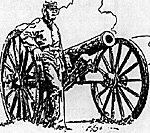 The reputation of the artillery arm at the
start of the Civil War was very high due to its
outstanding performance during the Mexican War. It
was felt that artillery was egually effective whether
employed offensively or defensively. However,
battlefield performance of artillery in the Civil War
would seem to disprove this. Indeed, by the end of
the war, many participants of both sides were quite
skeptical of the offensive value of the artillery.
The reputation of the artillery arm at the
start of the Civil War was very high due to its
outstanding performance during the Mexican War. It
was felt that artillery was egually effective whether
employed offensively or defensively. However,
battlefield performance of artillery in the Civil War
would seem to disprove this. Indeed, by the end of
the war, many participants of both sides were quite
skeptical of the offensive value of the artillery.
Massed artillery was unquestionably a powerful weapon when used on the defensive, and in numerous instances unsupported artillery repulsed enemy infantry attacks on its position. Numerous examples of effective defensive artillery employment occurred during the war. Some of the most famous would include the following:
-
l) Federal artillery at Malvern Hill
2) Confederate artillery at Fredricksburg
3) Federal artillery at Murfreesboro
4) Federal artillery at Hazel Grove and Fairview during battle of Chancellorsville
5) Federal artillery at Gettysburg
6) Federal artillery at Pittsburgh Landing and the Hornet's Nest during battle of Shiloh
When employed offensively, it appears that only limited or questionable effectiveness was achieved. Examples would include:
-
l) Federal artillery at Fredricksburg
2) Confederate artillery at Murfreesboro
3) Confederate artillery at Gettysburg
4) Confederate artillery at Chickamauga
5) Federal artillery at Antietam
6) Confederate artillery at Hazel Grove (Chancellorsville)
Captain Charles A. Phillips, a Union bauery commander at Gettysburg, later commented on the massive Confederate bombardment preceeding Pickett's Charge, saying that "beyond the noise that was made, no great harm was done".
Late in the war, especially during the siege at Petersburg, extensive entrenchments strengthened the tactical defensive and further diminished the offensive power of the artillery. Yet in most instances, a major assault was still preceded by an artillery bombardment, in the hope that it would weaken the defenders.
Some of the reasons for the artilleq's offensive ineffectiveness include the following:
1) Rifling improved infantry fire much more than artillery fire. Rifled artillery shells travelled at a high velocity, and often dug themselves deep into the ground where they exploded harmlessly, if at all. Also, due to their small caliber, most rifled guns fired canister much less effectively than smoothbore guns.
2) Rifled muskets greatly increased the range of infantry fire, and this made it difficult for artillery to support its own infantry in the attack. The smoothbore musket era tactic of charging the artillery forward to within canister range of the enemy and proceeding to blast huge gaps in this ranks was now virtually impossible without the enemy musketry decimating the crews and limber horses in short order.
3) The difficult, rugged terrain of North America limited the mobility, deployment, and effectiveness of the field guns. Few battlefields offered clear, open fields of fire, and even if they did, the targets would usually scurry to the nearest cover as soon as they were fired on. In most cases the rough terrain prevented the use of correct artillery tactics, that of massing a large number of guns combined with enfilading cross-fields of fire. To amass the necessary guns to do this usua1ly meant that guns had to be stripped away from the infantry brigades they were often attached to in a supporting role.
Effectiveness Measurement
It is very important that the effects of artillery fire are measured not in terms of the casualties it produced, but in terms of tactical advantages gained. Artillery cou1d and did break enemy units even when it caused very few casualties on them. Artillery had a shock power and a deterrent effect which was truly beyond statistical reckoning.
A major function of artillery during the war was to keep the enemy at bay so that he could not come to close quarters at all. This was, of course, a defensive employment of the field guns to support their infantry arm.
It must be realized that during the Napoleonic era, artillery was more powerful on the defensive than the offensive. Most of Napoleon's offensive artillery bombardments fell short of the desired effect, while defensive lines stiffened with properly deployed batteries were very successful. Civil War artillery appears to have been at least as effective as Napoleonic era artillery would have been when firing under similar conditions.
There is little evidence to suggest that the new longer range rifled guns had any significant tactical effect. At long range their direct fire was too lightweight, and indirect fire was too inaccurate to be useful.
I want to conclude by stating that I am fully aware that this is and has always been a controversial subject, and it is not the intent of this article to at last put the controversy to rest. This has been a hotly debated topic for over 130 years now, and it's never going to end! I just wanted to present some of the key facts to the readers of The Zouave.
Back to The Zouave Vol VII No. 2 Table of Contents
Back to The Zouave List of Issues
Back to Master Magazine List
© Copyright 1993 The American Civil War Society
This article appears in MagWeb (Magazine Web) on the Internet World Wide Web.
Other military history articles and gaming articles are available at http://www.magweb.com